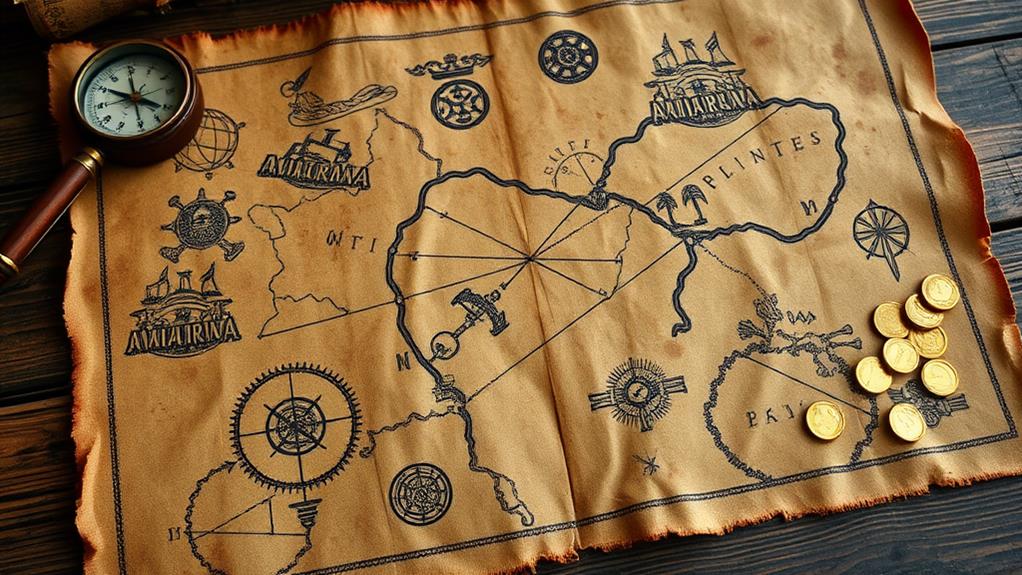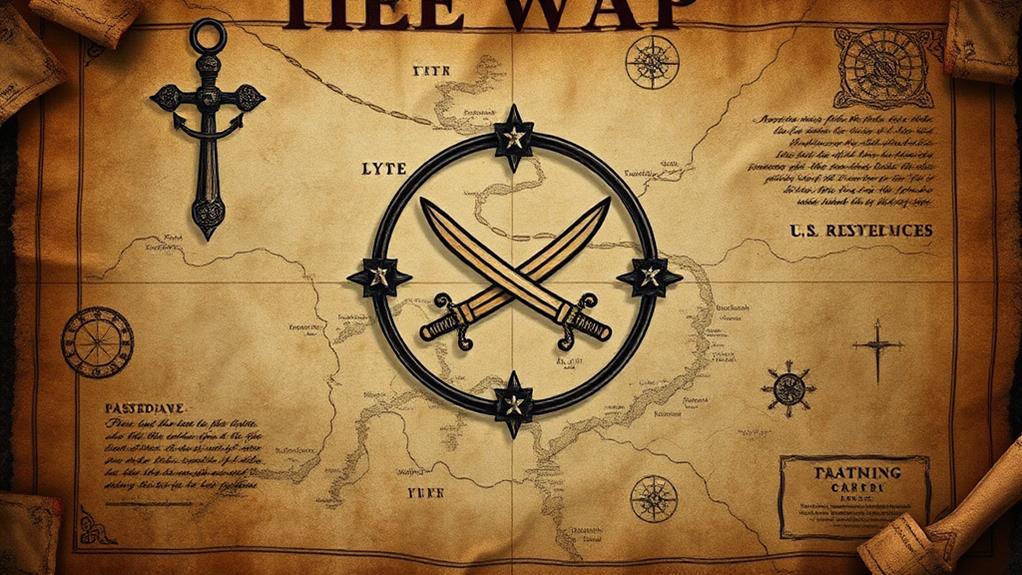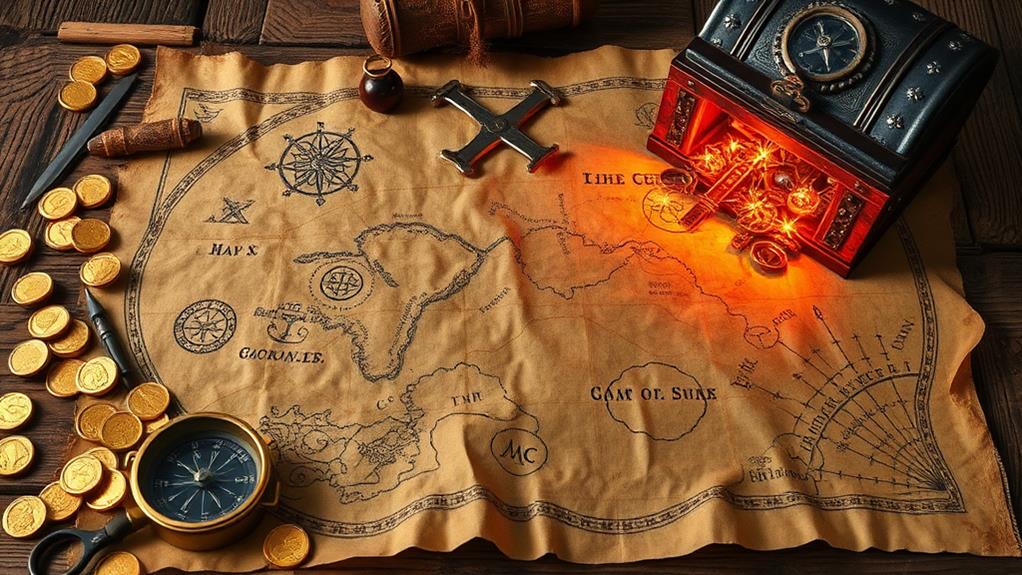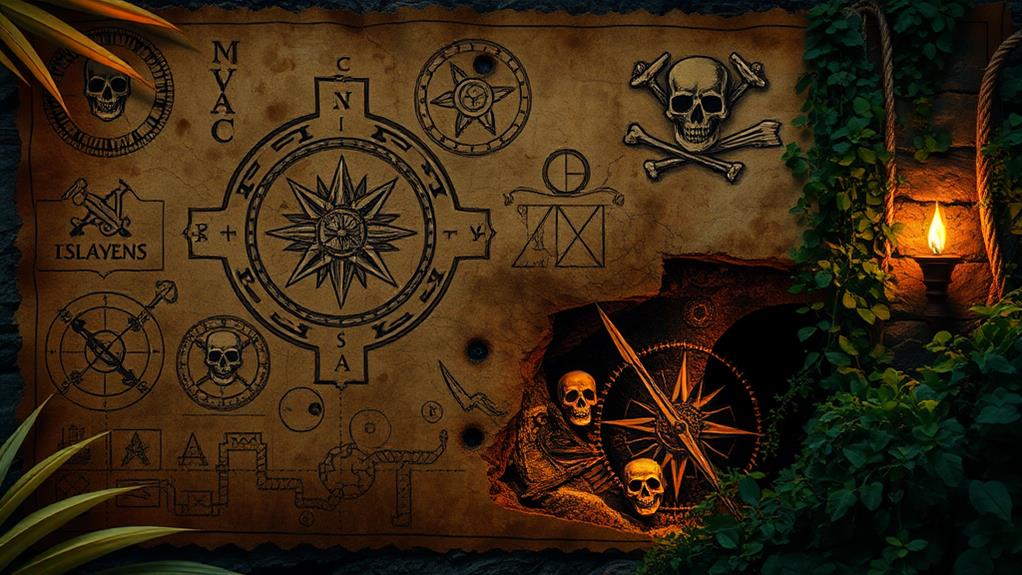
Decoding symbols on ancient pirate maps lets you decipher the hidden treasures of the past. Crossed swords warn of battles or lurking dangers, while skulls and bones highlight perilous zones filled with traps or hostile forces. Treasure chests mark where riches lie buried, often at intersections with other symbols like palm trees. Compass roses guide your direction, ensuring you're on the right path. Hidden caves, sometimes marked by cryptic phrases, conceal coveted loot, and mysterious islands hold both rewards and risks. Unravel these enigmatic markings, and you'll uncover the secrets these legendary maps hold.
Crossed Swords

The symbol of crossed swords on ancient pirate maps often signifies hidden dangers or battles fought over treasure. When you encounter this mark, it's a clear warning that the path ahead is fraught with peril. Pirates used these symbols to communicate the presence of rival crews, traps, or fierce creatures that guarded the coveted loot.
As you navigate the map, pay close attention to the placement of the crossed swords. If they're near a specific landmark, it likely means a significant skirmish occurred there, making it a hotspot for potential ambushes or lingering threats. You'll want to be prepared for anything, so arm yourself and stay vigilant.
Crossed swords also serve as a reminder of the pirate code and the constant struggle for supremacy among seafarers. They're not just decorative; they're a legacy to the bravery and treachery that defined pirate life. By understanding these symbols, you can better anticipate the risks and rewards that lie ahead. So, when you see those crossed swords, remember: they're a signal to proceed with caution and courage.
Skulls and Bones
Skulls and bones on ancient pirate maps aren't mere decorations; they're ominous warnings of danger and death. When you spot these symbols, you should proceed with extreme caution. Pirates used them to mark areas where peril lurked, whether it was a deadly trap, a treacherous landscape, or the territory of hostile forces. These symbols served as a universal language of caution among seafarers.
Here are some key points to keep in mind when you encounter skulls and bones on a pirate map:
- Dangerous Traps: Pirates often set traps to protect their treasures or deter rivals. These could be hidden pits, rigged explosives, or other lethal mechanisms.
- Hostile Territories: Areas marked with skulls and bones might indicate regions controlled by fierce pirate factions or hostile locals, making them hazardous to enter.
- Natural Hazards: These symbols might also denote natural dangers like quicksand, venomous creatures, or treacherous waters that could spell doom for the unwary.
- Cursed Locations: Some maps might use skulls and bones to signify places believed to be cursed or haunted, deterring even the bravest adventurers.
Understanding these symbols can mean the difference between life and death on your pirate quest. Proceed wisely!
Treasure Chests

After traversing the perils marked by skulls and bones, your ultimate goal is often the coveted treasure chest. These symbols on ancient pirate maps usually indicate the final destination where the wealth lies buried. Crucial to recognize the varied depictions of treasure chests, as they can differ greatly from one map to another.
Typically, a treasure chest symbol will feature a box shape, often with reinforced corners and a prominent lock. Some maps might show the chest slightly ajar, hinting at the riches within. The chest is usually placed at the intersection of other symbols, like palm trees, rocks, or an X marking the spot.
Understanding these nuances is crucial. For instance, if a chest is flanked by wavy lines, it might be hidden near water. If it's surrounded by stars or a crescent moon, it could imply a nighttime retrieval. Knowing these details helps you prepare appropriately.
Keep in mind, pirate maps are often designed to mislead. Some chests might be decoys, directing you to false locations. So, always cross-reference with other symbols and clues on the map to verify you're digging in the right spot. Your treasure awaits!
Compass Roses
Charting ancient pirate maps requires a keen understanding of compass roses, which serve as crucial guides for direction. You'll find them prominently displayed, often intricately designed, at the center or corners of the map. These symbols, usually star-shaped, indicate cardinal directions—north, south, east, and west—helping you navigate treacherous waters and unknown territories.
To decode these essential symbols, pay attention to:
- Orientation: The top of the compass rose typically points north, but on some maps, especially older ones, this isn't always the case. Double-check the map's legend.
- Design Variations: Pirate maps may feature unique, ornate designs, including additional points that mark intermediate directions, such as northeast or southwest.
- Symbols and Colors: Colors like red and gold often highlight important directions. Look for symbols like fleur-de-lis or arrows to signify north.
- Scale and Detail: Larger, more detailed compass roses might include degrees or other navigational aids, giving you a clearer sense of direction.
Understanding these elements guarantees you won't lose your way while deciphering the secrets of pirate maps. Keep your eyes peeled for these intricate designs, and you'll be well on your way to uncovering hidden treasures.
Hidden Caves

With your compass rose knowledge firmly in hand, you're now ready to tackle one of the most thrilling aspects of pirate maps: hidden caves. These secretive spots often held the most coveted treasures, and deciphering their symbols can be both a challenging and exhilarating experience.
Pirates used various symbols to denote hidden caves, often employing imagery like skulls, crossed bones, or even simple 'X' marks. These symbols were usually placed near coastal outlines or mountain ranges, indicating where you should start your search. Sometimes, the cave entrance would be marked with a cryptic phrase or riddle, requiring a keen eye and sharp mind to decode.
Pay close attention to the scale of the map and any landmarks, such as peculiar rock formations or unique trees. These natural features are vital for pinpointing the exact cave location. When you spot a suspicious symbol, cross-reference it with the map's legend to confirm its significance.
Mysterious Islands
Mysterious islands on pirate maps often hold the promise of untold riches and adventure. As you explore into these ancient charts, you'll notice that these islands are usually depicted with cryptic symbols and enigmatic clues. Each mark on the map can lead you to hidden treasures or perilous traps. Understanding these symbols is vital for any would-be treasure hunter.
Some common symbols and what they might signify:
- Skull and Crossbones: Beware! This often marks a dangerous area, possibly guarded by traps or hazardous terrain.
- Palm Tree: Look for hidden coves or fresh water sources, essential for survival on long voyages.
- X Marks the Spot: The classic treasure marker, indicating where the loot is buried or hidden.
- Anchor: Suggests a safe harbor or a place to dock your ship, often near the treasure site.
At a Glance
As you stand on the brink of discovery, the ancient pirate map unfurls its final secrets. Crossed swords whisper tales of fierce battles; skulls and bones hint at dire warnings. Your heart races as the compass rose guides you, a treasure chest's promise glinting in your mind. Just ahead, the hidden cave beckons, shadows concealing untold riches. Will you uncover the mysteries of the mysterious island, or will its secrets remain forever buried? The choice is yours.






